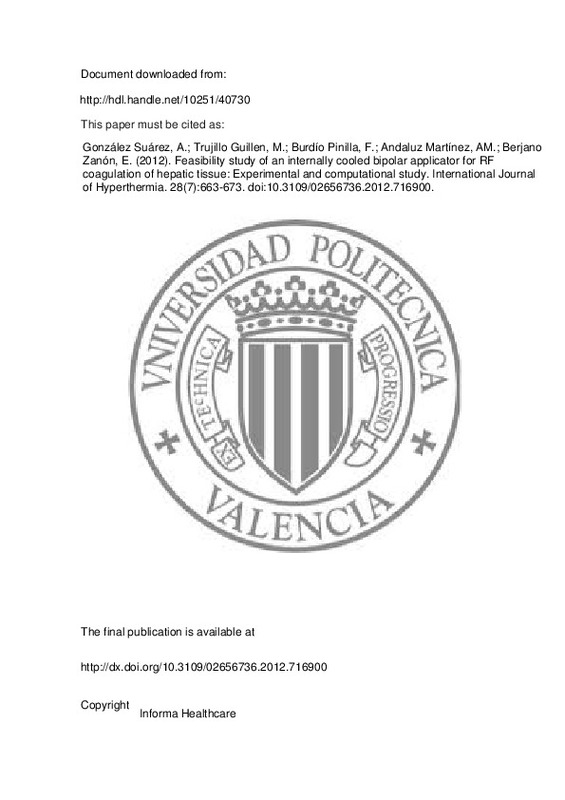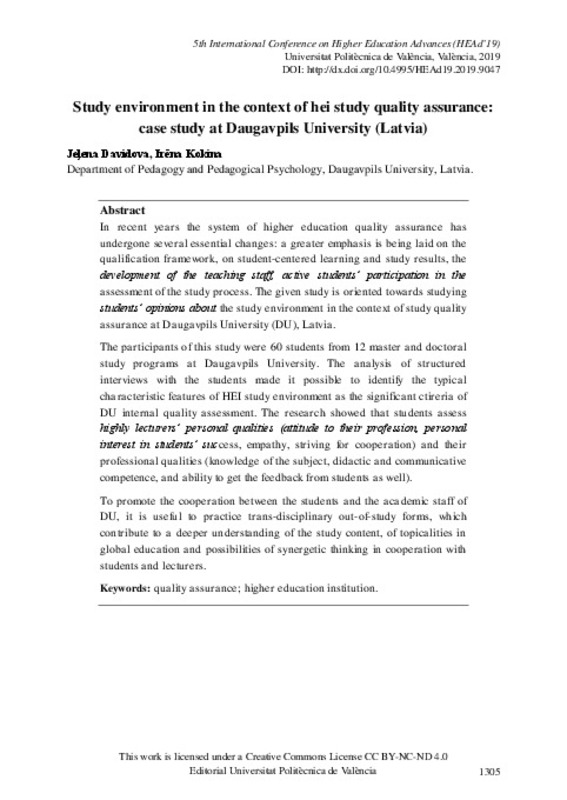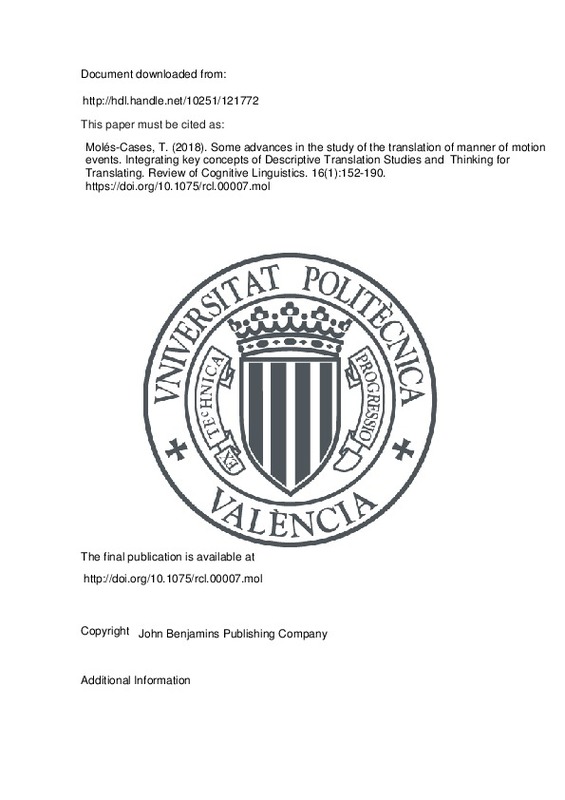JavaScript is disabled for your browser. Some features of this site may not work without it.
Buscar en RiuNet
Listar
Mi cuenta
Estadísticas
Ayuda RiuNet
Admin. UPV
Feasibility study of an internally cooled bipolar applicator for RF coagulation of hepatic tissue: Experimental and computational study
Mostrar el registro sencillo del ítem
Ficheros en el ítem
| dc.contributor.author | González Suárez, Ana
|
es_ES |
| dc.contributor.author | Trujillo Guillen, Macarena
|
es_ES |
| dc.contributor.author | Burdío Pinilla, Fernando
|
es_ES |
| dc.contributor.author | Andaluz Martínez, Ana María
|
es_ES |
| dc.contributor.author | Berjano Zanón, Enrique
|
es_ES |
| dc.date.accessioned | 2014-10-08T10:02:19Z | |
| dc.date.available | 2014-10-08T10:02:19Z | |
| dc.date.issued | 2012-12 | |
| dc.identifier.issn | 0265-6736 | |
| dc.identifier.uri | http://hdl.handle.net/10251/40730 | |
| dc.description.abstract | Purpose: To study the capacity of an internally cooled radiofrequency (RF) bipolar applicator to create sufficiently deep thermal lesions in hepatic tissue. Materials and methods: Three complementary methodologies were employed to check the electrical and thermal behaviour of the applicator under test. The experimental studies were based on excised bovine (ex vivo study) and porcine liver (in vivo study) and the theoretical models were solved by means of the finite element method (FEM). Results: Experimental and computational results showed good agreement in terms of impedance progress and lesion depth (4 and 4.5 mm respectively for ex vivo conditions, and approximately 7 and 9 mm respectively for in vivo conditions), although the lesion widths were overestimated by the computer simulations. This could have been due to the method used to assess the thermal lesions; the experimental lesions were assessed by the white coagulation zone, whereas the tissue damage function was used to assess the computational lesions. Conclusions: The experimental results suggest that this applicator could create in vivo lesions to a depth of around 7mm. It was also observed that the thermal lesion is mainly confined to the area between both electrodes, which would allow lesion width to be controlled by selecting a specific applicator design. The comparison between the experimental and computational results suggests that the theoretical model could be usefully applied in further studies of the performance of this device. © 2012 Informa UK Ltd All rights reserved. | es_ES |
| dc.description.sponsorship | This work received financial support from the Spanish Plan Nacional de I+D+I del Ministerio de Ciencia e Innovacion TEC2011-27133-C02-(01 and 02), from Universitat Politecnica de Valencia (INNOVA11-01-5502; and PAID-06-11 Ref. 1988). A. Gonzalez-Suarez is the recipient of grant VaLi+D (ACIF/2011/194) from the Generalitat Valenciana. The proof-reading of this paper was funded by the Universitat Politecnica de Valencia, Spain. The authors alone are responsible for the content and writing of the paper. | en_EN |
| dc.language | Inglés | es_ES |
| dc.publisher | Informa Healthcare | es_ES |
| dc.relation.ispartof | International Journal of Hyperthermia | es_ES |
| dc.rights | Reserva de todos los derechos | es_ES |
| dc.subject | Experimental model | es_ES |
| dc.subject | Finite element method | es_ES |
| dc.subject | Hepatic resection | es_ES |
| dc.subject | Internally cooled bipolar electrode | es_ES |
| dc.subject | Radiofrequency ablation | es_ES |
| dc.subject | Animal experiment | es_ES |
| dc.subject | Animal tissue | es_ES |
| dc.subject | Blood clotting | es_ES |
| dc.subject | Controlled study | es_ES |
| dc.subject | Electric conductivity | es_ES |
| dc.subject | Electrode | es_ES |
| dc.subject | In vivo study | es_ES |
| dc.subject | Ex vivo study | es_ES |
| dc.subject | Experimental study | es_ES |
| dc.subject | Feasibility study | es_ES |
| dc.subject | Finite element analysis | es_ES |
| dc.subject | Impedance | es_ES |
| dc.subject | Liver | es_ES |
| dc.subject | Nonhuman | es_ES |
| dc.subject | Radiation applicator | es_ES |
| dc.subject | Radiofrequency | es_ES |
| dc.subject | Radiofrequency radiation | es_ES |
| dc.subject | Simulation | es_ES |
| dc.subject | Thermal injury | es_ES |
| dc.subject | Tissue injury | es_ES |
| dc.subject.classification | MATEMATICA APLICADA | es_ES |
| dc.subject.classification | TECNOLOGIA ELECTRONICA | es_ES |
| dc.title | Feasibility study of an internally cooled bipolar applicator for RF coagulation of hepatic tissue: Experimental and computational study | es_ES |
| dc.type | Artículo | es_ES |
| dc.identifier.doi | 10.3109/02656736.2012.716900 | |
| dc.relation.projectID | info:eu-repo/grantAgreement/MICINN//TEC2011-27133-C02-02/ES/EXPERIMENTACION PARA TECNICAS ABLATIVAS BASADAS EN ENERGIA/ | es_ES |
| dc.relation.projectID | info:eu-repo/grantAgreement/MICINN//TEC2011-27133-C02-01/ES/MODELADO TEORICO Y EXPERIMENTACION PARA TECNICAS ABLATIVAS BASADAS EN ENERGIAS/ | es_ES |
| dc.relation.projectID | info:eu-repo/grantAgreement/UPV//PAID-06-11-1988/ | es_ES |
| dc.relation.projectID | info:eu-repo/grantAgreement/UPV//INNOVA11-01-5502/ | es_ES |
| dc.relation.projectID | info:eu-repo/grantAgreement/GVA//ACIF%2F2011%2F194/ | es_ES |
| dc.rights.accessRights | Abierto | es_ES |
| dc.contributor.affiliation | Universitat Politècnica de València. Departamento de Ingeniería Electrónica - Departament d'Enginyeria Electrònica | es_ES |
| dc.contributor.affiliation | Universitat Politècnica de València. Departamento de Matemática Aplicada - Departament de Matemàtica Aplicada | es_ES |
| dc.description.bibliographicCitation | González Suárez, A.; Trujillo Guillen, M.; Burdío Pinilla, F.; Andaluz Martínez, AM.; Berjano Zanón, E. (2012). Feasibility study of an internally cooled bipolar applicator for RF coagulation of hepatic tissue: Experimental and computational study. International Journal of Hyperthermia. 28(7):663-673. https://doi.org/10.3109/02656736.2012.716900 | es_ES |
| dc.description.accrualMethod | S | es_ES |
| dc.relation.publisherversion | http://dx.doi.org/10.3109/02656736.2012.716900 | es_ES |
| dc.description.upvformatpinicio | 663 | es_ES |
| dc.description.upvformatpfin | 673 | es_ES |
| dc.type.version | info:eu-repo/semantics/publishedVersion | es_ES |
| dc.description.volume | 28 | es_ES |
| dc.description.issue | 7 | es_ES |
| dc.relation.senia | 230190 | |
| dc.contributor.funder | Ministerio de Ciencia e Innovación | es_ES |
| dc.contributor.funder | Universitat Politècnica de València | es_ES |
| dc.contributor.funder | Generalitat Valenciana | es_ES |
| dc.description.references | Topp, S. A., McClurken, M., Lipson, D., Upadhya, G. A., Ritter, J. H., Linehan, D., & Strasberg, S. M. (2004). Saline-Linked Surface Radiofrequency Ablation. Annals of Surgery, 239(4), 518-527. doi:10.1097/01.sla.0000118927.83650.a4 | es_ES |
| dc.description.references | Gnerlich, J. L., Ritter, J. H., Linehan, D. C., Hawkins, W. G., & Strasberg, S. M. (2009). Saline-Linked Surface Radiofrequency Ablation. Annals of Surgery, 250(1), 96-102. doi:10.1097/sla.0b013e3181ae91af | es_ES |
| dc.description.references | Sakamoto, Y., Yamamoto, J., Kokudo, N., Seki, M., Kosuge, T., Yamaguchi, T., … Makuuchi, M. (2004). Bloodless liver resection using the Monopolar Floating Ball plus Ligasure diathermy: Preliminary results of 16 liver resections. World Journal of Surgery, 28(2), 166-172. doi:10.1007/s00268-003-7167-5 | es_ES |
| dc.description.references | Poon, R. T., Fan, S. T., & Wong, J. (2005). Liver resection using a saline-linked radiofrequency dissecting sealer for transection of the liver. Journal of the American College of Surgeons, 200(2), 308-313. doi:10.1016/j.jamcollsurg.2004.10.008 | es_ES |
| dc.description.references | EVERETT IV, T. H., LEE, K. W., WILSON, E. E., GUERRA, J. M., VAROSY, P. D., & OLGIN, J. E. (2008). Safety Profiles and Lesion Size of Different Radiofrequency Ablation Technologies: A Comparison of Large Tip, Open and Closed Irrigation Catheters. Journal of Cardiovascular Electrophysiology, 20(3), 325-335. doi:10.1111/j.1540-8167.2008.01305.x | es_ES |
| dc.description.references | Yokoyama, K., Nakagawa, H., Wittkampf, F. H. M., Pitha, J. V., Lazzara, R., & Jackman, W. M. (2006). Comparison of Electrode Cooling Between Internal and Open Irrigation in Radiofrequency Ablation Lesion Depth and Incidence of Thrombus and Steam Pop. Circulation, 113(1), 11-19. doi:10.1161/circulationaha.105.540062 | es_ES |
| dc.description.references | Demazumder, D., Mirotznik, M. S., & Schwartzman, D. (2001). Journal of Interventional Cardiac Electrophysiology, 5(4), 391-400. doi:10.1023/a:1013241927388 | es_ES |
| dc.description.references | Cooper, J. M., Sapp, J. L., Tedrow, U., Pellegrini, C. P., Robinson, D., Epstein, L. M., & Stevenson, W. G. (2004). Ablation with an internally irrigated radiofrequency catheter: Learning how to avoid steam pops. Heart Rhythm, 1(3), 329-333. doi:10.1016/j.hrthm.2004.04.019 | es_ES |
| dc.description.references | Burdío, F., Grande, L., Berjano, E., Martinez-Serrano, M., Poves, I., Burdío, J. M., … Güemes, A. (2010). A new single-instrument technique for parenchyma division and hemostasis in liver resection: a clinical feasibility study. The American Journal of Surgery, 200(6), e75-e80. doi:10.1016/j.amjsurg.2010.02.020 | es_ES |
| dc.description.references | Ríos, J. S., Zalabardo, J. M. S., Burdio, F., Berjano, E., Moros, M., Gonzalez, A., … Güemes, A. (2011). Single Instrument for Hemostatic Control in Laparoscopic Partial Nephrectomy in a Porcine Model Without Renal Vascular Clamping. Journal of Endourology, 25(6), 1005-1011. doi:10.1089/end.2010.0557 | es_ES |
| dc.description.references | Dorcaratto, D., Burdío, F., Fondevila, D., Andaluz, A., Poves, I., Martinez, M. A., … Grande, L. (2012). Laparoscopic Distal Pancreatectomy: Feasibility Study of Radiofrequency-Assisted Transection in a Porcine Model. Journal of Laparoendoscopic & Advanced Surgical Techniques, 22(3), 242-248. doi:10.1089/lap.2011.0417 | es_ES |
| dc.description.references | Zeh, A., Messer, J., Davis, J., Vasarhelyi, A., & Wohlrab, D. (2010). The Aquamantys System—An Alternative To Reduce Blood Loss in Primary Total Hip Arthroplasty? The Journal of Arthroplasty, 25(7), 1072-1077. doi:10.1016/j.arth.2009.10.008 | es_ES |
| dc.description.references | Sprunger, J., & Herrell, S. D. (2005). Partial Laparoscopic Nephrectomy Using Monopolar Saline-Coupled Radiofrequency Device: Animal Model and Tissue Effect Characterization. Journal of Endourology, 19(4), 513-519. doi:10.1089/end.2005.19.513 | es_ES |
| dc.description.references | Voeller, R. K., Zierer, A., Lall, S. C., Sakamoto, S., Schuessler, R. B., & Damiano, R. J. (2010). Efficacy of a novel bipolar radiofrequency ablation device on the beating heart for atrial fibrillation ablation: A long-term porcine study. The Journal of Thoracic and Cardiovascular Surgery, 140(1), 203-208. doi:10.1016/j.jtcvs.2009.06.034 | es_ES |
| dc.description.references | Pai, M., Spalding, D., Jiao, L., & Habib, N. (2012). Use of Bipolar Radiofrequency in Parenchymal Transection of the Liver, Pancreas and Kidney. Digestive Surgery, 29(1), 43-47. doi:10.1159/000335732 | es_ES |
| dc.description.references | Berjano, E. J. (2006). BioMedical Engineering OnLine, 5(1), 24. doi:10.1186/1475-925x-5-24 | es_ES |
| dc.description.references | Tungjitkusolmun, S., Staelin, S. T., Haemmerich, D., Jang-Zern Tsai, Hong Cao, Webster, J. G., … Vorperian, V. R. (2002). Three-dimensional finite-element analyses for radio-frequency hepatic tumor ablation. IEEE Transactions on Biomedical Engineering, 49(1), 3-9. doi:10.1109/10.972834 | es_ES |
| dc.description.references | Doss, J. D. (1982). Calculation of electric fields in conductive media. Medical Physics, 9(4), 566-573. doi:10.1118/1.595107 | es_ES |
| dc.description.references | Abraham, J. P., & Sparrow, E. M. (2007). A thermal-ablation bioheat model including liquid-to-vapor phase change, pressure- and necrosis-dependent perfusion, and moisture-dependent properties. International Journal of Heat and Mass Transfer, 50(13-14), 2537-2544. doi:10.1016/j.ijheatmasstransfer.2006.11.045 | es_ES |
| dc.description.references | Jo, B., & Aksan, A. (2010). Prediction of the extent of thermal damage in the cornea during conductive keratoplasty. Journal of Thermal Biology, 35(4), 167-174. doi:10.1016/j.jtherbio.2010.02.004 | es_ES |
| dc.description.references | Pearce, J., Panescu, D., & Thomsen, S. (2005). Simulation of diopter changes in radio frequency conductive keratoplasty in the cornea. Modelling in Medicine and Biology VI. doi:10.2495/bio050451 | es_ES |
| dc.description.references | Yang, D., Converse, M. C., Mahvi, D. M., & Webster, J. G. (2007). Expanding the Bioheat Equation to Include Tissue Internal Water Evaporation During Heating. IEEE Transactions on Biomedical Engineering, 54(8), 1382-1388. doi:10.1109/tbme.2007.890740 | es_ES |
| dc.description.references | Zhao, G., Zhang, H.-F., Guo, X.-J., Luo, D.-W., & Gao, D.-Y. (2007). Effect of blood flow and metabolism on multidimensional heat transfer during cryosurgery. Medical Engineering & Physics, 29(2), 205-215. doi:10.1016/j.medengphy.2006.03.005 | es_ES |
| dc.description.references | Pätz T, Körger T, Preusser T, Simulation of radiofrequency ablation including water evaporation. In: IFMBE Proceedings of the World Congress on Medical Physics and Biomedical Engineering 25/IV, 2009, 1287–1290 | es_ES |
| dc.description.references | Berjano, E. J., Burdío, F., Navarro, A. C., Burdío, J. M., Güemes, A., Aldana, O., … Gregorio, M. A. de. (2006). Improved perfusion system for bipolar radiofrequency ablation of liver: preliminary findings from a computer modeling study. Physiological Measurement, 27(10), N55-N66. doi:10.1088/0967-3334/27/10/n03 | es_ES |
| dc.description.references | Burdío, F., Berjano, E. J., Navarro, A., Burdío, J. M., Grande, L., Gonzalez, A., … Lequerica, J. L. (2009). Research and development of a new RF-assisted device for bloodless rapid transection of the liver: Computational modeling and in vivo experiments. BioMedical Engineering OnLine, 8(1), 6. doi:10.1186/1475-925x-8-6 | es_ES |
| dc.description.references | Chang, I. A., & Nguyen, U. D. (2004). BioMedical Engineering OnLine, 3(1), 27. doi:10.1186/1475-925x-3-27 | es_ES |
| dc.description.references | Beop-Min Kim, Jacques, S. L., Rastegar, S., Thomsen, S., & Motamedi, M. (1996). Nonlinear finite-element analysis of the role of dynamic changes in blood perfusion and optical properties in laser coagulation of tissue. IEEE Journal of Selected Topics in Quantum Electronics, 2(4), 922-933. doi:10.1109/2944.577317 | es_ES |
| dc.description.references | Panescu, D., Whayne, J. G., Fleischman, S. D., Mirotznik, M. S., Swanson, D. K., & Webster, J. G. (1995). Three-dimensional finite element analysis of current density and temperature distributions during radio-frequency ablation. IEEE Transactions on Biomedical Engineering, 42(9), 879-890. doi:10.1109/10.412649 | es_ES |
| dc.description.references | González-Suárez A, Alba J, Trujillo M, Berjano E, Experimental and theoretical study of an internally cooled bipolar electrode for RF coagulation of biological tissues. Conf Proc IEEE Eng Med Biol Soc 2011;6878–6881 | es_ES |
| dc.description.references | Rosenberg, A. G. (2007). Reducing Blood Loss in Total Joint Surgery With a Saline-Coupled Bipolar Sealing Technology. The Journal of Arthroplasty, 22(4), 82-85. doi:10.1016/j.arth.2007.02.018 | es_ES |
| dc.description.references | PETERSEN, H. H., ROMAN-GONZALEZ, J., JOHNSON, S. B., HASTRUP SVENDSEN, J., HAUNSO, S., & PACKER, D. L. (2004). Mechanisms for Enlarging Lesion Size During Irrigated Tip Radiofrequency Ablation:. Is There a Virtual Electrode Effect? Journal of Interventional Cardiology, 17(3), 171-177. doi:10.1111/j.1540-8183.2004.09879.x | es_ES |







![[Cerrado]](/themes/UPV/images/candado.png)




